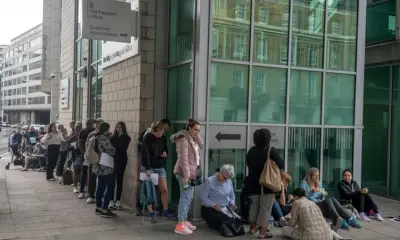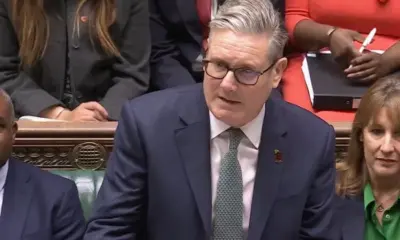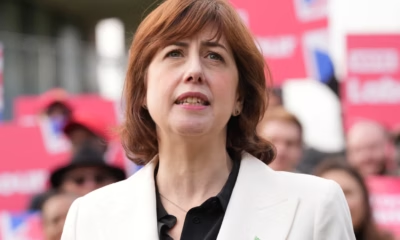Politics
PM Sunak Faces Cabinet Reshuffle Amid Election Countdown

As the United Kingdom approaches a crucial general election year, Prime Minister Rishi Sunak is preparing to reshuffle his cabinet in what analysts describe as a defining moment for his leadership. The move comes as the government seeks to reestablish voter confidence, address internal party divisions, and present a cohesive economic and social vision ahead of the national polls. The forthcoming reshuffle is expected to determine not only the political tone of the coming months but also the credibility of the administration’s strategy on growth, cost of living, and public services.
The anticipation surrounding the reshuffle has generated considerable attention within Westminster. Senior party figures suggest that several ministers may be replaced with new faces aligned more closely with the prime minister’s long-term agenda. The decision is being framed as an effort to inject energy into the government and strengthen the policy message that the current leadership remains focused on stability and competence after years of volatility in British politics.
Political Climate and Leadership Strategy
The timing of the reshuffle reflects the growing urgency within Downing Street to reconnect with an electorate that has grown weary of economic uncertainty and political infighting. Polling data indicates that public satisfaction with government performance has been inconsistent, with many voters citing cost-of-living pressures and public sector strikes as top concerns. Sunak’s team believes that a recalibrated cabinet could reinforce confidence in his ability to deliver on key promises before campaigning intensifies.
The reshuffle is also expected to balance internal factions within the governing party. Insiders note that the prime minister is seeking to unite moderates and traditional conservatives under a pragmatic policy platform focused on fiscal discipline, national security, and innovation. By bringing in figures with strong administrative records, the government hopes to shift public attention from internal disputes to measurable results on the economy and healthcare.
In recent months, the prime minister has placed emphasis on restoring economic momentum through investment in infrastructure, technology, and green energy. The new cabinet lineup will likely reflect these priorities, with departments encouraged to coordinate closely on initiatives that stimulate private sector growth and reduce regional inequality. Analysts argue that this reshuffle represents more than political maneuvering; it signals a strategic recalibration to strengthen governance in a pre-election environment.
Policy Direction and Public Expectations
Policy analysts predict that the next cabinet will focus on demonstrating tangible progress in key policy areas before the election. Economic management remains central to this effort. With inflation beginning to ease and interest rates expected to stabilize, the government aims to highlight fiscal prudence while promising targeted relief for households. Measures addressing housing affordability, small-business support, and energy efficiency are anticipated to feature prominently in the revised agenda.
Education and healthcare are also expected to receive renewed attention. Ongoing teacher shortages and strain on the National Health Service have become focal points in public debate. The prime minister is reportedly considering appointing reform-minded ministers who can implement modernization plans without sparking large-scale disruptions. His advisers view such appointments as essential for restoring credibility in the government’s ability to manage essential public services effectively.
On the international stage, foreign policy stability remains a priority. The UK continues to play an active role in European and global diplomacy, and continuity in foreign and defense leadership is likely to be maintained. The reshuffle, therefore, is not only about domestic repositioning but also about signaling reliability to international partners. This approach aligns with the broader objective of projecting a message of steady governance during a period of geopolitical complexity.
Reactions Within and Beyond Westminster
The prospect of a cabinet overhaul has prompted varying reactions among lawmakers and commentators. Supporters within the governing party argue that the prime minister’s strategy demonstrates decisiveness and an awareness of voter sentiment. They view the reshuffle as a chance to reintroduce a sense of purpose and professionalism that could appeal to undecided voters. Critics, however, question whether structural changes alone can reverse years of declining trust in political institutions.
Opposition leaders have responded by framing the reshuffle as evidence of internal instability. They argue that the government’s challenges stem from policy outcomes rather than personnel choices. Despite the criticism, political observers agree that a successful reshuffle could provide a short-term boost in public perception if accompanied by clear messaging and visible policy delivery. Media analysts point out that presentation will be as crucial as substance, with voters looking for authenticity rather than slogans.
For the prime minister, the coming weeks will be a delicate balancing act. Replacing senior ministers risks alienating key factions, while maintaining the status quo could be perceived as complacency. The effectiveness of this reshuffle will depend on his ability to integrate experience with renewal and to communicate a coherent vision that resonates beyond party lines.
Conclusion
As the countdown to the general election accelerates, the prime minister’s cabinet reshuffle represents both a political gamble and an opportunity. It offers a moment to reset the government’s agenda, reenergize the administration, and shape the public narrative ahead of a fiercely competitive campaign season. Whether this strategy succeeds will depend not only on who occupies key posts but on how effectively the government translates its policy ambitions into real-world improvements for citizens.
The coming months will reveal whether the reshuffle serves as a turning point or a temporary reprieve. For now, Westminster remains watchful as the political landscape evolves and the nation prepares for a decisive year in its democratic journey.




















